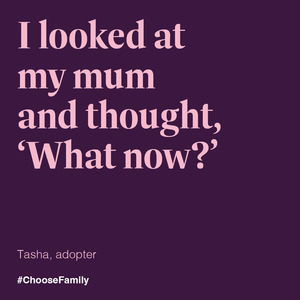
Tasha, from mid-west Wales, first considered adoption when she was just a teenager. Moved by documentaries about orphanages across the world, she wanted to give a home to children who needed it. After becoming a teacher, Tasha saw firsthand the number of children who needed loving and supportive homes in the UK – and realised her dream of adopting may be slightly closer to home.
From sending her first enquiry email in 2013, to today, as a single adopter of two children with additional learning needs.
This is Tasha’s story…
“When I sent off my initial enquiry to adopt, my family told me that they wouldn’t want me because I’m single, I work full-time as a teacher, I’ve got a dog, and I thought, ‘Well who are THEY? And why wouldn’t they want me?’
“I went into the process with a very open-mind. I didn’t have a picture in my mind of what sort of child I’d like to adopt. Gender or ethnicity wasn’t something that I had a preference about, but I did share that I’d try to keep sibling groups together if it was suitable for my situation.”
“I was aware that older children are often waiting the longest to be adopted, and I did let my social worker know that this would be a preference to reduce childcare costs as I was adopting on my own.
“The whole process was thorough and rigorous but necessary, although I did think it would take longer as I had some things against me, such as being overweight and being single. However, as I was a single adopter, they only had to assess one person, so I feel that made it a bit quicker.
“When I was approved, my social worker told me about two young siblings, a boy and a girl, who came from a sibling group of four (their older siblings were in long-term foster care).
“I was initially hesitant as I had expressed a preference for school-age children. However, I took my time to consider it and realised, following my year off from work after they came home, that the eldest would be in school. I was also very fortunate as the adoption team were able to put together some financial support to help with childcare costs for the youngest.
“My social worker did a lot of work with me on what to expect with the introductory phase – we created a booklet with photos of myself, and I gave them teddies and little trinkets to familiarise them with me.
“The two weeks of introductions were intense, but I tried to do everything by the book.
“When they came home, I tried to stick to the routines the foster carers had put in place, as I didn’t want to disrupt the norm for them.
“My family bought a pile of clothes and toys for them, which I kept in my garage for a period because they already had possessions, and I didn’t want them to feel overwhelmed by lots of new stuff.
“I think my family were initially nervous as they live over two hours away and wouldn’t be there for on-hand support. However, my mum was part of the ‘coming home’ phase, and when we put them to bed on the first night, they settled so quickly. I looked at my mum and thought, ‘What now?’ because it was all very seamless.
“Although they settled in well, in the early days, I did have internal feelings of guilt as my youngest’s foster carer had looked after him since he was six weeks old, so it must’ve been hard saying goodbye.
“My children have additional learning needs; my son has an official diagnosis, but we’re still waiting to see the paediatrician for my daughter. My son’s foster carer told me that he was an energetic child so that diagnosis wasn’t a surprise when he was older; with my daughter it’s been a little more difficult to spot the signs.
“Yes, there may be some additional challenges due to their additional needs, but we’ve taken it in our stride as a family. With any child, there will be bumps in the road as they grow up.
“For anyone considering adopting children with more complex needs, or even adopting full stop, I would advise to just go for it. When you have birth children, you don’t always know what they’ll turn out like, and it’s the same with adopting.”
Read more about the #ChooseFamily campaign on the National Adoption Website


